
Coolgardie–Esperance Highway is a 370-kilometre (230 mi) Western Australian highway between Coolgardie and Esperance. It runs in a north–south direction linking the state's Eastern Goldfields to the coast.
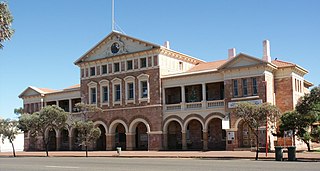
Coolgardie is a small town in Western Australia, 558 kilometres (347 mi) east of the state capital, Perth. It has a population of approximately 850 people.
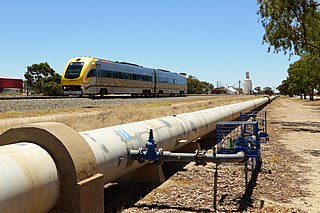
The Eastern Goldfields Railway, was built in the 1890s by the Western Australian Government Railways to connect Perth with the Eastern Goldfields at Coolgardie and Kalgoorlie.

Civil disturbances in Western Australia include race riots, prison riots, and religious conflicts – often Protestant versus Catholic groups.

The Goldfields Water Supply Scheme is a pipeline and dam project that delivers potable water from Mundaring Weir in Perth to communities in Western Australia's Eastern Goldfields, particularly Coolgardie and Kalgoorlie. The project was commissioned in 1896 and completed in 1903.
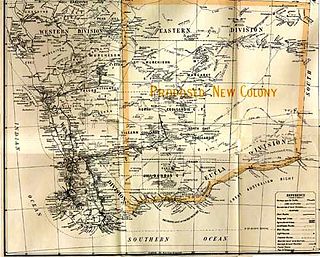
Auralia was a proposed colony that would have been formed out of the south-eastern portion of the colony of Western Australia in the early twentieth century, and would have joined the newly formed Commonwealth of Australia.
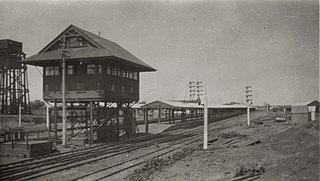
Kalgoorlie railway station is the easternmost attended station in Western Australia, located at the eastern terminus of the Eastern Goldfields Railway. It serves the city of Kalgoorlie. Beyond Kalgoorlie, the line continues east as the Trans-Australian Railway.
The Western Argus was a newspaper published in Kalgoorlie, Western Australia, between 1894 and 1938.

Beria is an abandoned town in the Goldfields-Esperance region of Western Australia, located 8 kilometres (5 mi) north of Laverton on the Laverton-Leonora Road.
Bardoc is an abandoned town in the Goldfields-Esperance region of Western Australia. It is situated between Kalgoorlie and Menzies along the Goldfields Highway.
Yundamindera, also once known as The Granites, is an abandoned town located between Leonora and Laverton in the Shire of Leonora in the Goldfields–Esperance region of Western Australia. The town is surrounded by pastoral stations, mostly raising sheep. Some of the leases include Yundamindera Station, Mount Remarkable Station and Mount Celia Station.
Kintore is an abandoned town in Western Australia located 46 kilometres (29 mi) north-west of Kalgoorlie along the Coolgardie North Road in the Goldfields-Esperance region of Western Australia.
Mulwarrie is an abandoned town in the North Coolgardie Goldfield of the Goldfields-Esperance region of Western Australia, 125 km northwest of Kalgoorlie, between Davyhurst and Mulline.
Alfred Thomas Chandler was a journalist, editor and newspaper proprietor in Victoria, South Australia and Western Australia. He was prominent in the Western Australian secession movement.
The Coolgardie Miner was a weekly newspaper established in Coolgardie, Western Australia, at a time when Coolgardie was the prominent town in the goldfields region of Western Australia.

Andrew Oswald Wilson (1866–1950), known professionally as A. Oswald Wilson, was an early-20th-century Western Australian architect. Born and trained as a carpenter in Victoria, he moved first to Perth and then to the Eastern Goldfields, where he worked for Murdock McKay Hopkins. He was president of the Mechanics' Literary and Debating Society in Boulder from 1904 to 1908, as well as active in the Boulder Benevolent Society. One of his best-known buildings is the Boulder town hall for which he submitted designs in 1907. In December 1908, he moved back to Perth and practised from Forrest Chambers.
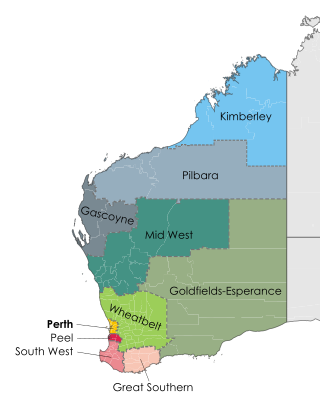
This is a list of newspapers published in, or for, the Goldfields–Esperance region of Western Australia.

The Chamber of Minerals and Energy of Western Australia (CME) is the peak organisation for mining businesses and employers in Western Australia (WA).
Robert Silvers Black was mine manager of Kalgurli Mines.
The Menzies Miner was a weekly newspaper based in the mining town of Menzies, Western Australia, which operated from 1895 to 1901.










